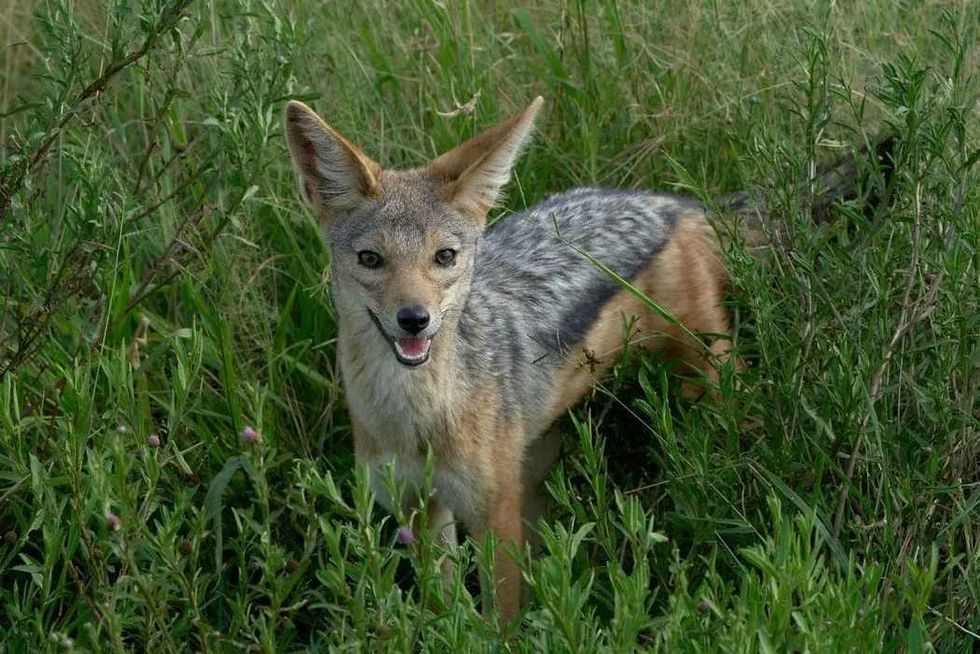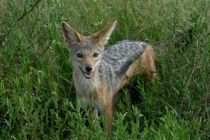Did you ever hear a dog-like animal howling loudly in the middle of the night? The howls were that of a jackal.
Jackals are small-sized canine animals related to dogs, hyenas, wolves, and coyotes as they all fall under the same genus, Canis. There are three main species of jackals: golden jackal or common jackal (Canis aureus), side-striped jackal (Canis adustus), and black-backed jackal (Canis mesomelas).
Another cross-species of jackal and dog called the canid hybrid is found in several places. The howls of the jackals can be heard more prominently during the long nights of the winter months. They are omnivorous but are predated by hyenas, large eagles, and vultures.
Jackals are very protective and reserved in nature. They protect their territory and their pups with all their might and can become very fierce if threatened.
Keep on reading to know more interesting facts about the jackals of the world.
If you like this article, check out the Kunming wolfdog and the Italian wolf.
Jackal Interesting Facts
What type of animal is a Jackal?
A jackal is an omnivorous animal, often confused with wolves, foxes, and domestic dogs. Jackals have a mediumly-built slender physique with long legs making them swift chasers of their prey.
What class of animal Jackal belongs to?
Jackals belong to the class of mammals. They reproduce their young ones and can also feed them through mammary glands.
How many Jackals are there in the world?
The main three species of jackals are black-backed jackals, side-striped jackals, golden jackals, and common jackals. At present, there are no estimates of their exact population.
Where does a Jackal live?
A pack of jackals is found to stay amidst the woods, savannas, bushland, and long grassy plains.
What is a Jackal's habitat?
The different species of these small canine animals are found across several countries in Africa, Europe, and North America. The habitat of the jackals varies from place to place.
The common jackal, side-striped jackal, black-backed jackal prefer living in dry savannas, wet savannas, deserts, grasslands, woodlands, marshes, wetlands, and around bushes. Some of them are also found to live in urban areas keeping themselves distant from the human population. All jackals are found to live in groups called packs.
Each pack has a leader whom the others follow. Every jackal family occupies a common territory as their habitat.
Who do Jackals live with?
Jackals are found to live in packs in a particular territory. The male and female members are monogamous and live in pairs within their pack. Jackals are very loyal towards their packs who protect and stay together in harmony.
How long does a Jackal live?
A young jackal usually lives between eight to 12 years old in the wild. But when under conservation laws, their lifespan increases and ranges from 12 to 16 years.
How do they reproduce?
Jackals are a species of mammals that give birth to their young ones. They are monogamous by nature and mate with the same partner for their entire life.
In their marked territory, male and female jackals live in pairs and mate with each other. The gestation period of a female jackal is up to two months, after which an average of four young pups are born.
The eyes of the jackal pups open 10 days after they are born.
They are kept safe in holes or thickets for up to three weeks, after which they start to move around and play with other jackals. The parents nourish and take care of the pups for six months after which the small jackals become independent and start hunting on their own.
What is their conservation status?
Jackals at present are listed as a species of Least Concern in the IUCN Red List. Be it the side-striped jackal, common jackal, golden jackal, or black-backed jackal, all the subspecies are found in large numbers in their territories all over the world.
However, these animals are facing an increasing concern of habitat encroachment leading to the shortage of food and consequent malnourishment due to poor diet. Many jackals found solo or in pairs in urban areas are attacked by humans which is significantly affecting their population.
The African Wildlife Organisation, among others, is conserving the species of jackals to keep their numbers in check.
Jackal Fun Facts
What does a Jackal look like?

Jackals are mediumly built animals with long legs, large feet, furry tails, and differently colored bodies. Their long and slender legs enable them to run at fast speeds to catch prey or ward off predators.
They resemble wild dogs, foxes and wolves. They have very strong and sharp canines and jaws.
The tail of these animals is long and bushy.
Although their body structure is the same, the remarkable color differences bring out the distinction among the three species.
The common jackal or golden jackal has a golden yellow color running all across its body, the neck to tail is black and the rest of the body has a ginger-yellow color, black-backed jackals, and side-striped jackals have white and black stripes on their tan color bodies.
How cute are they?
Jackals are cute-looking animals with small canines. Their slender and dog-like body structure gives them a cute appearance. Their small face with a large tail and long legs and ginger-brown body color make them look cute. On a scale of one to 10, jackals can be rated a seven for their cuteness.
How do they communicate?
A jackal communicates verbally via high-pitched howls which sounds similar to a siren. The jackal parents howl to ward off enemies, others howl before setting out to hunt, the intensity of howling increases during their mating months. A jackal is mostly heard to be howling at night, as dawn to dusk is their most active time.
How big is a Jackal?
Jackals are small canine animals with males being slightly bigger in size than females. The length of male jackals ranges from 28-33 in (71-75cm) and females ranging between 27-29 in (69-73 cm). A jackal is comparable to a wild dog. It is four times the size of a cat and twice as big as a puppy.
How fast can a Jackal run?
Jackals are very fast runners or chasers. They can attain a speed of up to 10mph (16kph) to hunt their prey or to escape from predators.
How much does a Jackal weigh?
Since the size of male jackals is bigger than their female counterparts, males usually weigh more than female jackals. Male jackals weigh between 13-31 lbs (6-14 kg) and female jackals weigh around 15-24 lbs (7-11 kg).
What are their male and female names of the species?
Male jackals are also called dogs while a female jackal doesn't have any assigned name.
What would you call a baby Jackal?
Baby jackals are called pups.
What do they eat?
A jackal is an omnivorous species that is known to hunt for its own food, and also has a plant-based diet. Most jackals set out for hunting at night and remain inactive during the day.
A jackal is a nocturnal predator that gathers food like small mammals, hares, rodents, small reptiles, birds, carrion, antelope, fruits, berries, and a few plants. Monogamous pairs of jackals search for food in their own territory and are great at scavenging on other animals.
Are they dangerous?
Yes, jackals are dangerous predators with an extremely quarrelsome and aggressive nature. Jackal parents are very protective about their pups and can tear off chunks of flesh if they feel threatened.
A single jackal can be fought by a person but it can get very difficult to fight with jackal pairs as they surround and attack with their sharp canines and strong feet. They shy away from humans but can become quite dangerous when the members of their territory are provoked.
Would they make a good pet?
A jackal is a wild animal and it is best to leave them on their own in the wild. It is not a good option to pet them. It is better to pet any dog that looks somewhat related to jackals. They can be conserved like in the African Wildlife Organisation, where they have a friendly relationship with humans.
Did you know...
A pack of jackals is also known as a jackal tribe.
Jackal packs mark and protect their land with their urine and faeces from other stranger jackals.
All jackals of a pack are found to be extremely fond and friendly towards each other. While an egoistic relation is maintained with other jackals from different packs.
Jackals are sometimes referred to as toned-down hyenas. But the fun fact is hyenas prey on jackals
Jackals are symbolic of power, loneliness, intelligence, pride, cunning, and a mix of all of these qualities.
Often side-striped jackals (Canis adustus) hoot like owls rather than howling.
Apart from a fight, jackals only respond to calls from within their family. Other calls from stranger jackals are generally ignored.
The Jackal's call
The jackal's call can help one search jackal territory. They communicate with the members of their pack by giving out high-pitched howls, screams, and yells.
Where does the Jackal originate from?
Different species of jackals have different places of origin. The origin of the golden jackals can be traced back to eastern Europe and Southeast Asia. The black-backed and side-striped jackals are known to have originated in Southern and Eastern Africa.
Here at Kidadl, we have carefully created lots of interesting family-friendly animal facts for everyone to discover! Learn more about some other mammals including the husky wolf mix and the tundra wolf.
You can even occupy yourself at home by drawing one of our jackal coloring pages.










